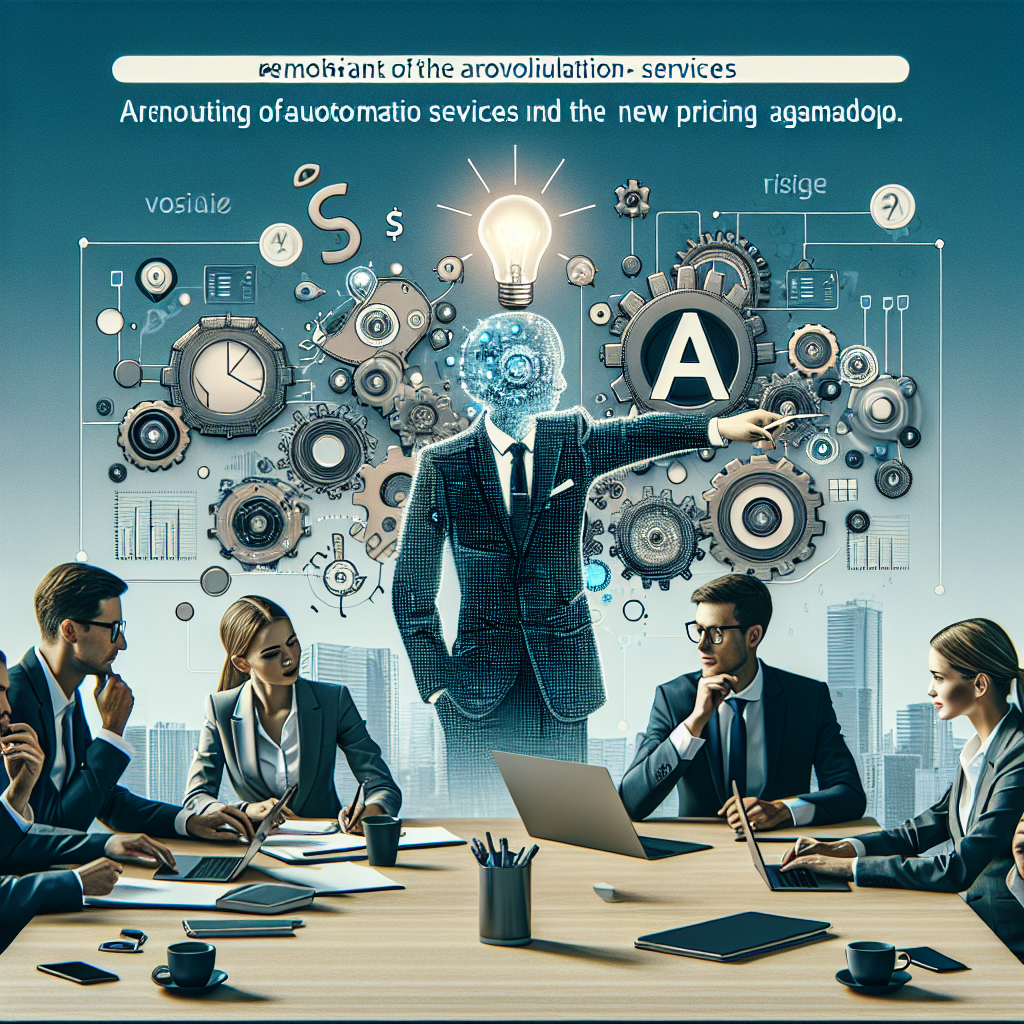Revolutionizing AI Automation Services: The New Pricing Paradigm
In the rapidly evolving landscape of artificial intelligence and automation, businesses are constantly seeking innovative ways to stay competitive and maximize their efficiency. One *crucial* aspect that often determines the success of AI automation services is the pricing model. As the industry matures, a new approach to pricing these services is emerging, promising to reshape how businesses engage with and benefit from AI-driven solutions.
This comprehensive analysis delves into the latest trends in AI automation service pricing, exploring the shift towards more flexible and value-driven models. We’ll examine the factors driving this change, the potential benefits for both service providers and clients, and how this new paradigm is set to impact the future of the AI automation industry.
The Evolving Landscape of AI Automation Services
The AI automation services market is experiencing unprecedented growth. According to recent industry analysis, the market is expected to grow by 15.3% annually through 2025. This rapid expansion is driven by businesses across various sectors recognizing the transformative potential of AI-powered automation in streamlining operations, enhancing decision-making processes, and driving innovation.
As the demand for these services continues to surge, service providers are reevaluating their pricing strategies to better align with client needs and market dynamics. The traditional project-based pricing model, while still prevalent, is increasingly being complemented or replaced by more flexible approaches that offer greater value and predictability for clients.
“I consider these conversations a pretty big gold mine of practical advice and I think that they are too valuable to keep hidden on that smaller channel.”
Nick Saraev
This sentiment from Nick Saraev, a prominent voice in the AI automation space, underscores the importance of sharing practical insights and evolving strategies within the industry. It’s this spirit of open dialogue and continuous improvement that is driving the shift towards more innovative pricing models.
The Rise of Retainer-Based Pricing
One of the most *significant* developments in AI automation service pricing is the growing adoption of retainer-based models. This approach represents a fundamental shift from one-off project pricing to a more sustained, partnership-oriented engagement between service providers and their clients.
“Retainers are just a recurring services model where instead of somebody paying you for a one-time project like I think most people probably think of services in the context of, they pay you every month usually.”
Nick Saraev
This model offers several advantages for both parties. For service providers, it ensures a more stable and predictable revenue stream, allowing for better resource allocation and long-term planning. Clients benefit from ongoing access to expertise and support, often at a more favorable rate compared to project-based pricing.
The Mechanics of Retainer Pricing
Under a retainer model, clients typically prepay for a set number of hours or a defined scope of services on a monthly basis. This arrangement provides a win-win situation: clients secure priority access to the service provider’s expertise, while providers gain financial stability and the opportunity to develop deeper, more strategic relationships with their clients.
“What a retainer allows you to do is the retainer allows you in exchange for some of this money you get the customer to lock in so they actually buy 20 hours at some discount let’s say $45 an hour now so you make $900 but the difference is they prepay so they pay you ahead of time.”
Nick Saraev
This prepayment aspect is *crucial*, as it not only improves cash flow for service providers but also encourages clients to fully utilize the services they’ve purchased, leading to more consistent engagement and better outcomes.
The Impact of Value-Based Pricing on AI Automation Services
While retainer models are gaining traction, they’re not the only innovation in AI automation service pricing. Value-based pricing is another approach that’s reshaping the industry. This model ties the cost of services directly to the measurable value they deliver to the client’s business.
Studies show that 73% of businesses implementing AI strategies see improved performance within 6 months. This statistic underscores the tangible value that AI automation services can bring to organizations, making value-based pricing an attractive option for both providers and clients.
“The integration of AI has become *essential* for companies looking to remain competitive in today’s market.”
Lisa Chen, Strategic Business Consultant at Innovation Partners LLC
Value-based pricing aligns the interests of service providers with their clients’ success. It incentivizes providers to focus on delivering measurable results and continuous improvement, rather than simply completing a predefined scope of work.
The Benefits of Flexible Pricing Models
The shift towards more flexible pricing models in AI automation services is driven by the numerous benefits they offer to both service providers and clients. Let’s explore some of the key advantages:
For Service Providers:
- Predictable Revenue: Retainer and subscription-based models provide a more stable income stream, allowing for better financial planning and resource allocation.
- Deeper Client Relationships: Ongoing engagements foster stronger partnerships and a better understanding of client needs, leading to more tailored and effective solutions.
- Opportunity for Upselling: Regular client interactions create more opportunities to identify and address additional needs, potentially expanding the scope of services.
For Clients:
- Cost Efficiency: Retainer models often come with discounted rates compared to project-based pricing, offering better value for ongoing services.
- Access to Expertise: Clients benefit from consistent access to specialized knowledge and support, enhancing their ability to leverage AI automation effectively.
- Scalability: Flexible pricing models allow clients to scale their use of AI automation services up or down based on their changing needs.
Market data indicates that AI adoption has increased by 45% since 2023. This rapid growth is partly facilitated by more accessible and flexible pricing models that allow a wider range of businesses to benefit from AI automation services.
Challenges and Considerations
While the new pricing paradigms offer *significant* advantages, they also come with challenges that both service providers and clients need to navigate:
For Service Providers:
- Resource Management: Balancing the needs of multiple retainer clients can be complex, requiring robust project management systems.
- Setting Appropriate Rates: Determining the right pricing for retainer or value-based models requires careful analysis and may involve some trial and error.
- Demonstrating Value: Providers must consistently show the tangible benefits of their services to justify ongoing engagements.
For Clients:
- Budget Allocation: Shifting to a retainer model requires adjusting budget strategies from project-based to ongoing operational expenses.
- Utilization Concerns: Ensuring full utilization of prepaid hours or services can be challenging and requires careful planning.
- Measuring ROI: Clients need to develop robust metrics to assess the ongoing value of AI automation services.
“The future of AI lies in understanding the intersection of technology and human behavior.”
Dr. Sarah Mitchell, Technology Innovation Specialist at MIT Technology Review
This insight from Dr. Mitchell highlights the importance of not just focusing on the technical aspects of AI automation, but also considering how these new pricing models align with client behaviors and expectations.
Implementing New Pricing Strategies: Best Practices
For service providers looking to adopt these new pricing models, consider the following best practices:
- Start with a Pilot Program: Test new pricing models with a select group of clients to gather feedback and refine your approach.
- Offer Flexible Options: Provide a range of pricing tiers or models to cater to different client needs and budgets.
- Emphasize Value Communication: Clearly articulate the benefits of your services and how they translate to tangible business outcomes.
- Invest in Relationship Management: Develop strong client relationships to ensure long-term success with retainer or value-based models.
- Continuously Measure and Adjust: Regularly assess the performance of your pricing strategies and be prepared to make adjustments based on client feedback and market conditions.
Research reveals that companies utilizing AI technologies report 28% higher efficiency rates. Service providers can leverage such statistics to demonstrate the potential value of their offerings and justify their pricing models.
The Future of AI Automation Service Pricing
As the AI automation industry continues to evolve, we can expect further innovations in pricing strategies. The trend towards more flexible, value-driven models is likely to accelerate, with an increasing focus on outcomes rather than inputs.
“What we’re seeing with AI is not just a trend, but a fundamental shift in how industries operate.”
Michael Thompson, Senior Industry Analyst at Global Business Insights
This shift will likely lead to more sophisticated pricing models that incorporate elements of performance-based compensation, shared risk/reward structures, and even AI-driven dynamic pricing that adjusts based on real-time value delivery.
Global spending on AI solutions is projected to reach $2.4 billion by 2025. This substantial investment underscores the growing importance of AI automation services and the need for pricing models that can accommodate this expanding market.
Conclusion: Embracing the New Pricing Paradigm
The evolution of pricing models in AI automation services represents a *significant* opportunity for both service providers and clients to derive greater value from their engagements. By moving towards more flexible, value-driven approaches like retainer-based and value-based pricing, the industry is fostering deeper partnerships and more sustainable business models.
For service providers, embracing these new pricing paradigms can lead to more predictable revenue streams, stronger client relationships, and opportunities for growth. Clients stand to benefit from more cost-effective access to AI expertise, better alignment of costs with value received, and the ability to scale their use of AI automation services more efficiently.
As the AI automation landscape continues to evolve, those who adapt to and innovate within this new pricing paradigm will be best positioned to thrive. By focusing on delivering measurable value and fostering long-term partnerships, both service providers and clients can unlock the full potential of AI automation technologies.





Leave a Reply